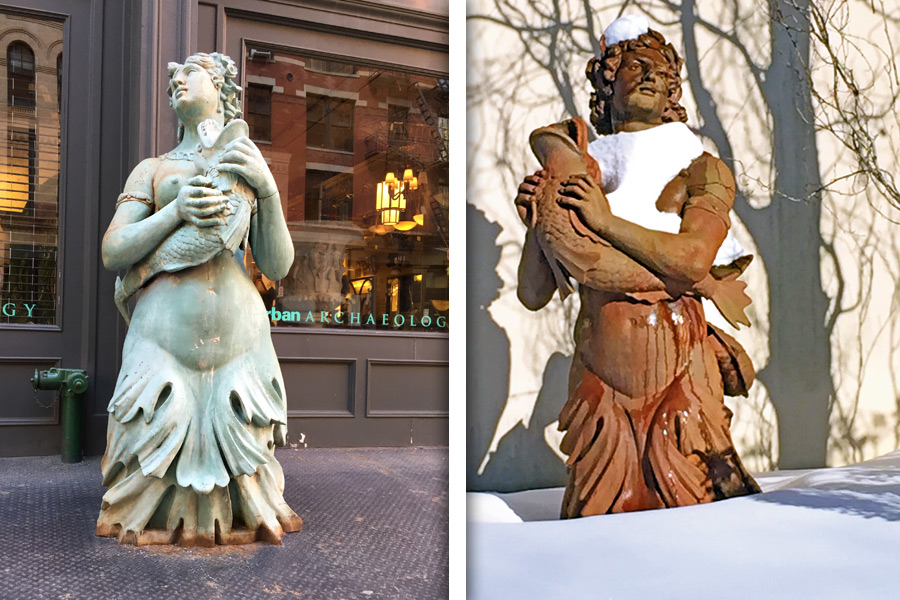Urban Archeology Auctions Nearly Priceless Mermen Statues

This weekend, March 27–28, the contents of the Urban Archaeology store, the store that sells giant antique sculptures, statuary, interior home fixtures and marble accessories, will be closing in Bridgehampton. The auction will also include objects from the vast warehouse in Jersey City where many heavy antique objects currently reside.
“We’d buy a one-ton granite wall panel from the office of an ad agency, stack it against the wall in the warehouse, and then, a month later, stack some big ironwork fence in front of it,” says Gil Shapiro, Urban Archeology’s owner. “So we haven’t known until now what’s there.”
Arlan Ettinger of Guernsey’s Auctions is a longtime Hamptonite with a home in Remsenberg. Gil Shapiro and his wife, Judith Stockman, have a house in Sagaponack. And the property where Urban Archeology lives is rented from Lou Meisel, also of Sagaponack.
Among the objects auctioned off of interest to East Enders will be a fabulous ironwork grand staircase railing that used to grace the Morton Saban mansion in Southampton, torn down 10 years ago to make way for the Sebonack Golf Course there. The railing, created in 1916 by ironworker Samuel Yellin, depicts almost every creature that lives amongst us on the eastern end of Long Island. There’s a robin feeding her chicks, there are turkeys, rabbits, deer and other creatures.
Of most interest, to me anyway, are two one-ton statues of mermen—full-sized naked men with fishtails—that for practically the whole 20 years this store has been in existence have sat, chained to concrete bases in the ground, out front of Urban Archeology, a store directly adjacent to the offices of Dan’s Papers in Bridgehampton at that time. Early on I came to learn the incredible story of how they got there. Many antiques have stories. These statues have the best story ever.
The statues had stood during the first half of the 20th century by a granite outdoor swimming pool on the property of a man who lived in New Jersey. When the man died around 1980, the man’s heirs put the property up for sale. But what to do with these outlandish, huge, iron statues? They contacted Christie’s and Sotheby’s who said they weren’t worth that much and weren’t interested. Then they contacted Urban Archeology, which one of the big houses said might be interested. Gil Shapiro, who had an Urban Archeology store in New York City at that time, offered $25,000 for the lot. From that, a long negotiation ensued, which resulted in these five pieces—three statues and two urns—being sold for $51,000.
Shapiro had them trucked to New York City and put on display there at his store on Franklin Street.
Around 1988, a California auction house called the store, said they had seen the statues out front there and would be interested in promoting them in Architectural Digest. Shapiro said that would be fine, but then was surprised to find, when the magazine came out in advance of the auction, that they were being listed at $250,000. Shapiro asked that auctioneer about this. He had hoped to get $80,000. The auctioneer assured him that, for whatever they sold, the auctioneer would just get his standard commission.
“I priced them so high,” Shapiro recalls the auctioneer saying, “for good luck at the auction.”
The statues never sold at this auction, but unfortunately the former owner of the statues saw Architectural Digest. It was still before auction day. They said they had been fooled into selling the statues to Urban Archaeology for $50,000. They filed a lawsuit. The matter went to court and the statues were removed from the auction.
Two years later, according to Shapiro, after he had spent hundreds of thousands of dollars in legal fees, the courts threw out the lawsuit of the New Jersey heirs, ruling that Shapiro had only had them offered up at the higher price because of auctioneer enthusiasm, and that if Christie’s and Sotheby’s had not seen any greater value in these statues, how could the owner of an antique store have known better?
Then one day, in 1989, Shapiro, on vacation in Sagaponack, came upon a new book published by Rizzoli, which featured old photographs of historic sites in Paris. One picture, a black-and-white photo taken in 1925, showed the Place de la Concorde and a grand circular wading pool several hundred feet across, out of which were emerging mermaids and mermen spouting water. The clipping said this monument had been built in the 1830s, to try to wipe away the trauma caused by the guillotining of King Louis and Marie Antoinette in that circle 10 years earlier.
But Shapiro couldn’t take his eyes off the statues. The statues in the picture were the ones he now had on Franklin Street in New York City.
Shapiro wrote the Louvre about this, and they replied that in the late 1920s, a few years after this photo was taken, the French government had decided to ask present-day sculptors to make new bronze statues for the pond, and the old ones, which were the ones in the photo, would be removed. These new ones, the ones there now, were in a similar style, but there with the mermen posed differently. The artists in 1929 had been told they could be creative if they wanted to be. Could they send someone to Franklin Street to have a look at them?
Seven people came, flying to New York on the supersonic jet in service back then they called the Concorde, from Paris to JFK. They included an appraiser, a representative of the Louvre, several workmen and several photographers. The statues were photographed and measured, and a small piece from one of them was chipped off and taken away.
A week later, on official Louvre stationery, came the answer.
These were the original statues, all right. And they would like to have them back. As to how they got to America, they had no idea. There were theories. Perhaps during the Depression the government took these originals away and hid them when they’d gotten the new ones, then lost track of them. But who really knew? The Louvre would like to negotiate for them.
Shapiro has a newspaper clipping that describes the results of these negotiations. The clipping is from The European, an English-language newspaper, and the date of publication was June 12, 1992. The headline is
PARIS BUYS BACK ITS MISSING MERMAN AND MERMAIDS.
The price would be $150,000 for each piece and the initial sale would be for two of the five pieces. But the sale never went through when, according to Shapiro, the French government would not let American planes use French airspace to aid Israel in a conflict with Hezbollah. The time was not right for such a sale, Shapiro said.
By that time, the Urban Archaeology store on the Montauk Highway in Bridgehampton had been in business for eight years, and so Shapiro, thinking he might have more luck with them out east, placed each of two mermen respectively on the eastern and western sides of the new building for all passersby to see, and for me—after I learned of this remarkable journey—to stare at them and contemplate them from my office window next door for the next 20 years.
Why didn’t anyone, in all these years, steal these two nearly priceless statues? Who knows? When things weigh more than a ton and are bolted into the ground, well, maybe it’s just too risky a business? Or maybe people just don’t steal things much in Bridgehampton? It’s certainly unlikely that thieves knew of this grand tale, anyway.
In writing this article for the upcoming auction, Shapiro gave me still another reason why they’d never been stolen. Underground, these priceless statues were not only bolted, but connected up to the store’s alarm
system. If they ever moved, alarms would sound.
The Bridgehampton Urban Archaeology is closing, but the two Urban Archaeology stores in New York City and the one in Chicago remain open. The auction takes place in the six-story Urban Archaeology Building at 143 Franklin Street, New York City, on March 27 and 28.









